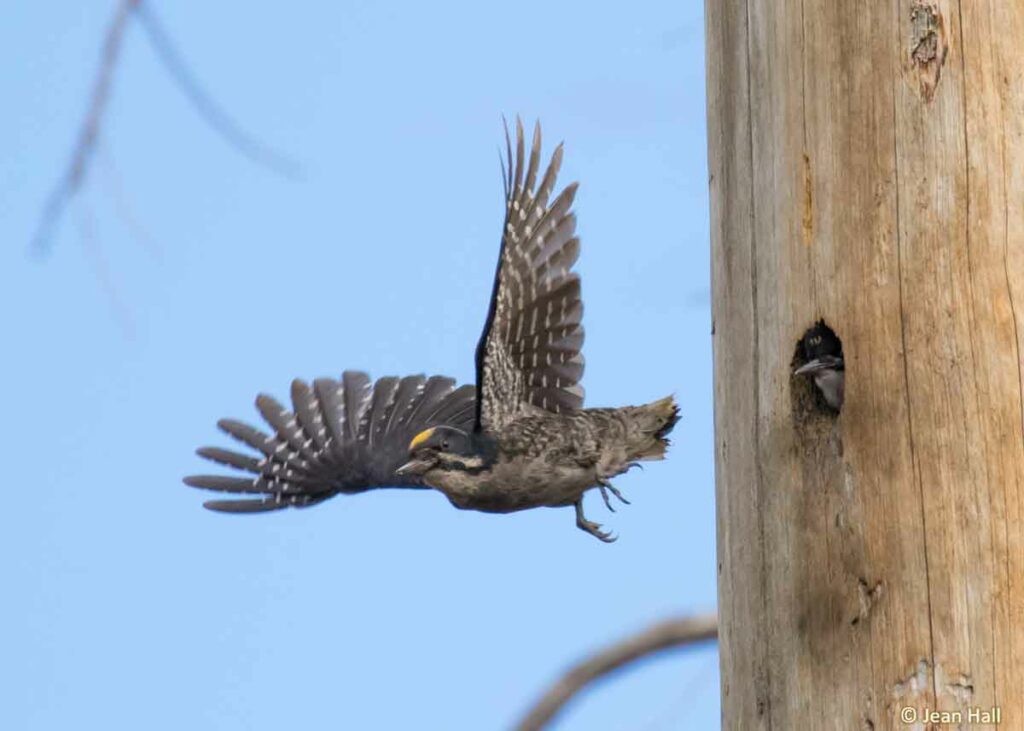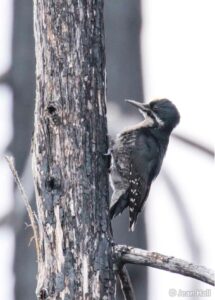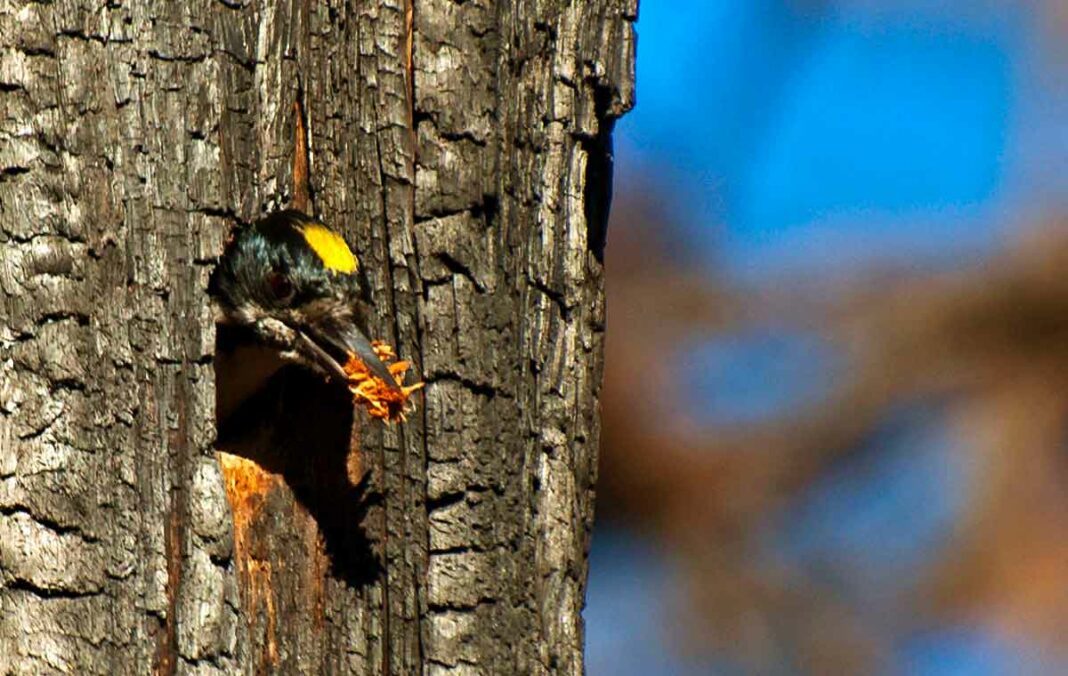By Cole Hersey
Two years ago, my father and I visited my brother in South Lake Tahoe. At the time he was leading bird surveys for Point Blue, a nonprofit research and conservation organization. He started working at Point Blue in 2014, first as an intern at their world-renowned Palomarin research station in the Point Reyes National Seashore, eventually becoming a crew leader for Point Blue in the Sierra Nevada. We arrived at his house in South Lake just before sunset and walked out into the open shrubland beyond his house. It was made up mostly of manzanita and mountain whitethorn bushes, with tall Jeffery pines and red fir dotting the flat expanse. This shrubland, my brother told us, was created by the Angora fire of 2007 which burned most of the 3,000-acre area to ash, destroying 254 homes in the process. This kind of fire, one that kills almost all plant-life in its path, is called a high-severity fire.
However, my brother pointed out that for wildlife this wasn’t necessarily bad. Even beyond the shrublands, in places burned completely black, he told me, wildlife thrives.
After a fire, many plants and animals—including western wood pewees, western bluebirds, morel mushrooms, wood-boring beetles, and, most notably, black-backed woodpeckers—begin to live in the burned areas.
“This bird [the black-backed woodpecker] screams fire,” said Dick Hutto, an emeritus professor at the University of Montana.

According to the Institute for Bird Populations (IBP), a non-profit bird research organization that recently relocated from Point Reyes Station to Petaluma, black-backed woodpeckers are much more common in recently burned forests of the Sierra Nevada, and rarer in unburned forests.
With their distinctive black backs that blend perfectly into burnt bark, this bird’s livelihood directly depends on severely burned forests. Due to their unique dependence on forest fires, black-backed woodpeckers in recent years have become a symbol of the importance of wildfires in the Western United States.
Recent studies conducted by IBP only solidify this. According to an article written by IBP this year, scientists found that black-backed woodpeckers are more likely to nest and forage in areas of high-severity fires.
“It’s a reflection of a long, evolutionary history,” Hutto said.
According to the same study, black-backed woodpeckers prefer to nest near low and mixed-severity burned areas, or on the edges of large burns, where their young can find better cover from potential predators. Due to this, some scientists believe that the fires we are seeing might not mean a boon for the birds.
“Habitat is being created for them, I don’t have any questions about that,” said Rodney Siegel, the executive director of IBP. “The question is, if there are these incredibly large high-severity patches, like we saw for example in the King fire [of 2014], there may be areas that are just too far from low-severity or unburned forests, so they just can’t set up a home range there.”
However, Siegel was quick to point out that the size of the fire wasn’t the important factor.
“From the woodpecker’s perspective, the size of the fire isn’t the issue, it’s the characteristics of the fire,” he said, referring to the size of areas within a fire that burned at high, mixed or low severity.
Regardless of the kinds of fires, these birds depend on them for their survival.
As Ryan Burnett, the senior Sierra group leader for Point Blue, recently said, “If we lost fire in the Sierra, we probably would lose the species.”
However, as the threat of fire increases across the Western United States, these areas where the black-backed woodpeckers thrive are under threat.
Usually, after a fire, the Forest Service and other organizations go to these high-severity sites and cut down many of the trees in order to replant the forest. Foresters call this “salvage logging.” The idea is that, since all of the seeds in the soil burned up, no trees will grow back for a long time, so they might as well cut the burned trees down and replant the forest. And, in the process, black-backed woodpeckers lose critical habitat.
“The idea that we can replant these places is just a 20th century fire-suppression ideal,” Burnett said, mentioning that he was working on an article about salvage logging and how it affects black-backed woodpeckers. What he and a team of scientists working with Point Blue found in their yet-to-be-published study is that salvage logging hurts black-backed woodpecker habitat. “It’s pretty unequivocal that salvage logging, at least within a home range of a black-backed woodpecker, is going to have negative consequences [for the bird].”
However, as fire seasons worsen due to climate change, and the patches of high-severity burns increase, there is concern that the forest may not be able to grow back fast enough.
“If there’s no forests, there’s no forests to burn,” Siegel said.
This fear has mounted over the course of this year’s fire season, in which over four million acres have burned, to date. As I write this in Marin, it is the first week of clear skies in almost two months. After consecutive years of fires devastating the state, with 18 of the largest 20 fires ever recorded occurring since 2003, large fires have become a regular seasonal occurrence. Summer is no longer a time to relax and go to the beach, but instead a time to be on high alert, to prepare for a sudden run from the fires.
“It’s not a choice of whether we have fires or want fire,” Burnett said. This is why we have to “fight fire with fire.”
Controlled burns create resilience in the Sierra, and other wildlands across California, by creating a mosaic of habitats within the forest, helping wildfires burn more naturally and with less potential to decimate entire towns.
And, as climate change makes fires larger and more difficult to control, the use of prescribed burns is more important than ever, for people and for wildlife such as the black-backed woodpecker. Yet, even as the Forest Service and other organizations understand that the best way to fight fire is with fire, they suppress more burns than they permit.
According to the United States Department of Agriculture, “The Forest Service and its partners suppress more than 98 percent of wildfires on initial attack, keeping unwanted fires small and costs down.” This means that only 2 percent of all fires that are started are out of control, even in such an unprecedented year as 2020.
“Prescribed fire and managed wildfire is really the only way to go,” said Malcolm North, a fire ecologist and professor at UC Davis. “There really isn’t any other choice.”
So, if prescribed burning helps protect people and towns, and wildlife such as black-backed woodpeckers, why do we suppress fires in areas where there is little threat to towns? North points to an overly cautious system.
“I’ll be blunt with you because I’ve worked in the Forest Service,” he said. “People know what they need to do. And Forest Service managers know that they need to have more fires on the landscape, but everything is working against [them]. The public doesn’t like the smoke, and if [the fire] escapes, your ass is on the line for liability. Everything is kind of against doing the right thing. Where this whole thing is going to change is if the public gets out from under the myth of Smokey the Bear and realizes that fires are inevitable.”
Smokey the Bear—co-created by the Ad Council and the Forest Service—has been the enlightened spokesman of fire suppression since he appeared in 1944. His message: wildfires can only be bad. Due to his incredibly successful public campaign, the forest management has used fire suppression as its main tool for close to a century fire. But, for many ecologists, this thinking is damaging.
“[Smokey the Bear] was a terribly misguided campaign,” Siegel said.
Referencing the movie Bambi, Dick Hutto said, “[The movie is saying] ‘all my forest friends are hurt and dying and dead. Won’t you be good and prevent forest fires?’”
And it seems that legislators are beginning to understand that Smokey the Bear was wrong.
According to the Mercury News, a new agreement between the federal government and California mandates that by 2025 one million acres of prescribed burning must be implemented every year. In the United States Senate, there is a new Emergency Wildfire and Public Safety Act on the floor, a bipartisan bill supported by Sen. Diane Feinstein (D-Calif.) and Sen. Steve Daines (R-Mont.), that aims to increase the ability for the Forest Service and other agencies to respond quicker to wildfires.
However, to Hutto, these bills neglect the bigger picture surrounding these landscapes.
“We’ve moved out of the cities and out into the wildlands, where 98 percent of the causes of fire are lightning and have been there forever,” Hutto said. “So you have this complicated message that needs to be more nuanced.”
Jack Cohen, a former researcher at the Forest Service, has fought since the 1990s to change the way the Forest Service thinks about fire. To Cohen, the best way to combat fires is to learn how to live with them. After seeing many photos of burned neighborhoods where the trees were unharmed by the fires, Cohen began studying the issue of burning homes and found that the Forest Service should be funding new ways of building houses that are fire resistant. Instead of fighting fires, Cohen thinks we should build better houses.

Ryan Burnett believes we need learn and be lead by the practices of Native American communities to live with fire, because, “there is no way our diesel-powered technology will get us there.”
If we learn to live with fire, many other animals, such as the black-backed woodpecker, will benefit.
As I sit here in Marin County, I can’t help but think about that open shrubland behind my brother’s house in South Lake, and how many years of mismanagement and natural processes allowed it to burn, to be “altered” into something new, as Burnett would say. Currently, there are 19 major wildfires burning in California. As the fire season nears its close, it is hard to say if these fires, such as the Creek Fire in Fresno and Madera Counties, will be good or bad for the black-backed woodpecker. We’ll only be able to know once the fires are over.
If there is anything to learn from the black-backed woodpecker, it is that fires are a natural part of the California landscape, and it might be time to bring fire back. It is, as Hutto said, about listening to the bird.
“If we’re willing to listen,” he said, “the insight we can get—of where it occurs and where it doesn’t occur—is profound. It tells us something about whether we’re behaving properly.”








